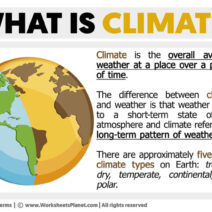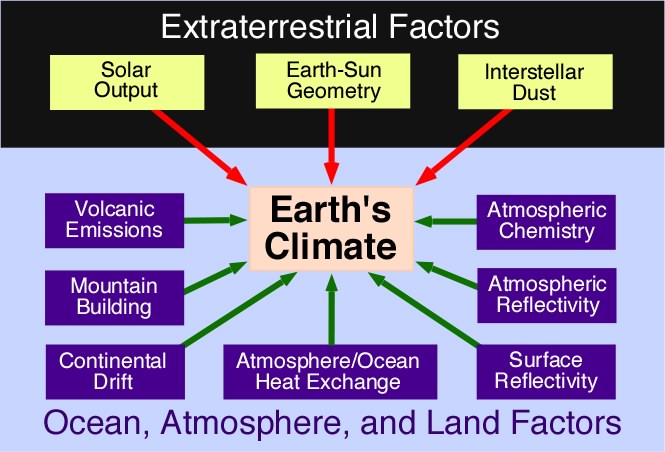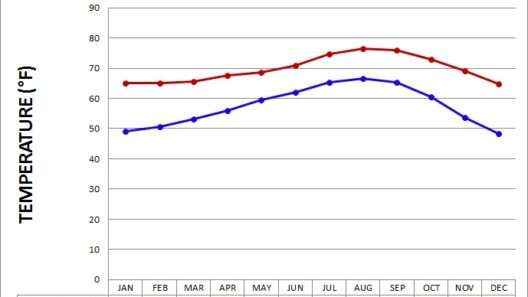The illustrious dance of nature unfolds in a breathtaking spectacle that transcends human perception. Clouds whisper secrets to the mountains, while oceans breathe, shifting in rhythm with the cosmos. In the grand tapestry of Earth’s existence, climate change emerges not merely as an emergent concern but as a perennial symphony of natural forces that sculpt the world we inhabit. It is vital to dissect the myriad factors that induce these natural fluctuations, for they serve as an eloquent reminder of our planet’s cyclical nature.
To comprehend what catalyzes these shifts, one must first traverse the intricate pathways of Earth’s geology, atmospheric dynamics, and cosmic influences. Each element plays a pivotal role, weaving an elaborate narrative that can be both awe-inspiring and complex.
Geological Contributions
The Earth’s crust is a veritable mosaic of tectonic plates, which shift and collide over geological time scales. This movement can lead to volcanic eruptions, which exhale vast quantities of ash and gases into the atmosphere. The particulate matter and sulfur dioxide emitted can create a temporary cooling effect by reflecting sunlight away from the Earth. Notable examples include the eruption of Mount Tambora in 1815, which precipitated the “Year Without a Summer,” drastically altering weather patterns worldwide.
Moreover, the gradual shifting of continents influences ocean currents and, consequently, climatic conditions. As landmasses drift, they alter the distribution of heat across the planet. Formidable mountain ranges, such as the Himalayas, can modify atmospheric circulation patterns, establishing rain shadows that transform vast regions of land from lush forests to arid deserts. In this way, the Earth’s topography is not merely a backdrop; it is an active participant in determining local and global climates.
Solar Variations
The sun, an omnipresent beacon of energy, also orchestrates climatic transformations through its cyclical behavior. Solar output is not constant; it ebbs and flows in cycles lasting approximately 11 years, a phenomenon known as the solar cycle. These variations can tilt the delicate balance of our atmosphere, influencing weather patterns and, occasionally, sparking climatic shifts.
Furthermore, historical records reveal that periods of reduced solar activity, such as the Maunder Minimum during the late 17th century, were correlated with notably colder climatic phases in Europe, suggesting a profound interrelation between solar dynamics and terrestrial weather. Nutation and axial tilt—subtle shifts in Earth’s orientation—affect the distribution and intensity of sunlight, creating further seasonal variations that have profound effects over millennia.
Greenhouse Gas Emissions from Natural Sources
While anthropogenic effects on climate have garnered substantial attention, natural sources of greenhouse gases cannot be overlooked. Methane, a potent greenhouse gas, is emitted from wetlands and through the decomposition of organic matter. As temperatures rise, permafrost in polar regions thaws, releasing stored quantities of methane that contribute to further warming—a feedback loop that exemplifies nature’s delicate balance.
Similarly, carbon dioxide is sequestered and released through both natural processes, such as respiration and volcanic activity, and human-induced phenomena. The pivotal interplay between these natural sources and human activity underscores the complexity of Earth’s climate systems and highlights the necessity of a nuanced understanding of these dynamics.
Oceanic Dynamics and Circulation
The world’s oceans, which cover more than 70% of the Earth’s surface, function as climate regulators. They absorb heat and carbon dioxide, creating a buffering effect that mitigates fluctuations in the atmosphere. Ocean currents, driven by wind patterns and differences in temperature and salinity, transport warm water from the equator to the poles, fundamentally influencing climate zones. The Great Ocean Conveyor Belt is a prime example, demonstrating how interconnected these systems are and elucidating the potential ramifications of disruptions within this delicate equilibrium.
El Niño and La Niña phenomena illustrate how even slight variations in ocean temperatures can induce dramatic changes in weather patterns worldwide. These oscillations can lead to severe droughts, floods, and hurricanes, marking the profound impact of the oceans on global climate. The interconnectedness and cyclical nature of oceanic and atmospheric interactions are reminiscent of a timeless dance, ever-changing yet perpetually in sync.
Shifting Biodiversity and Ecosystems
The shifting tapestry of climate also influences biological diversity. As temperature gradients change, species must adapt, migrate, or face annihilation. This evolutionary pressure can lead to shifts in ecosystems and trophic cascades, further complicating the ramifications of climate variability. For example, as warmer temperatures extend the growing seasons, plant species may flourish, providing sustenance to herbivores and subsequently affecting predator populations, illustrating the intricate web of dependencies that knit together ecological systems.
In this grand narrative of climate change, discernible patterns emerge as well. The historical record etched in glacial ice, sediment cores, and tree rings serves as a testament to the planet’s ever-evolving story. By studying these natural archives, scientists gain invaluable insights into the rhythms of the Earth, revealing that the dance of climate is as ancient as the planet itself.
In conclusion, the forces driving natural climate change are as diverse as they are intricate. From the geological upheavals that reshape the landscape to the subtle whispers of solar variations, each factor contributes to the cyclical secrets of our planet. Understanding these natural phenomena is crucial, for they not only illuminate the past but also guide humanity in its quest to navigate the challenges of a changing climate. It is within this interconnected web of influence that the unique appeal of our planet’s climate lies, ever precarious, yet magnificently resilient.








